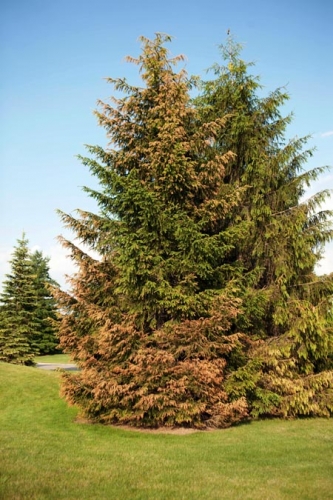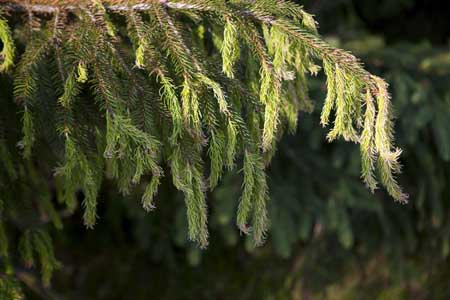Documenting suspected Imprelis injury
Keep photos, application records and samples if you have damaged trees.
Reports and photos of trees with suspected Imprelis damage continue to come in. As noted on MSU Extension News for Agriculture and on many other Extension websites, spruces and white pines in landscapes and on golf courses are showing severe needle and shoot injury (see photos) following application of Imprelis herbicide to adjacent turf. (See related article, What to do with Imprelis-affected trees). DuPont issued a statement on June 17 advising applicators to avoid using Imprelis near Norway spruce and white pine trees, but has not provided any further information beyond a notice on their website that they are investigating claims of injury to trees.

Suspected Imprelis injury on Norway spruce on a golf course near Ann Arbor. Photo credit: Don Wild

Suspected Imprelis injury on Norway spruce. Photo credit: Don Wild. Click here to see close-up of image.
Landscapers, lawn service operators and golf course managers may wish to document suspected injury while symptoms are apparent. This includes photographs of affected trees showing extent of injury and also close-up images of injury. Applicators should also maintain up-to-date application records. Since Imprelis is a relatively new product, there are presently no readily available analytical techniques to test soils or foliage, but this could change. Keith Henley, environmental lab manager for A&L Great Lakes Laboratories, suggests that applicators with suspected damage collect soil and foliar samples now and freeze them. As analytical standards and techniques become available, the samples can be thawed and analyzed at a later date.
Related articles:
Related resources:
A homeowner's guide to Imprelis herbicide injury to landscape trees
Michigan Department of Agriculture and Rural Development news release (June 28, 2011):
ISSUE ADVISORY REGARDING THE USE OF DuPont ™ Imprelis ™ Herbicide
The Michigan Department of Agriculture & Rural Development (MDARD) and other state pesticide regulatory agencies are receiving calls regarding suspected adverse effects related to DuPont ™ Imprelis ™ Herbicide. Commercial pesticide applicators are reporting that the application of DuPont ™ Imprelis ™ Herbicide to turf sites may be causing growth regulator type injury (twisting and curling of new growth) to their evergreens including Norway spruce and white pine. Some applicators are also reporting damage to other ornamental trees and shrubs like sugar maple and yews. DuPont ™ is aware of the issue.
DuPont ™ Imprelis ™ Herbicide label use directions include the following restrictions:
- Wait a minimum of 14 days to re-treat.
- Do not apply this product to exposed roots of trees and shrubs.
- Do not apply to any ornamental bed.
- Do not apply this product directly to, or allow spray drift to come into contact with, ornamental ground covers, foliage plants, flowers, trees, shrubs, nearby crop plants or other desirable plants; or to the soil where potentially sensitive plants will be planted in the same season.
- Do not use grass clippings from treated areas for mulching or compost, or allow for collection to composting facilities. Grass clippings must either be left on the treated area, or, if allowed by local yard waste regulations, disposed of in the trash.
- Applicators must give verbal or written notice to property owner/property manager/residents to not use grass clippings from treated areas for mulch or compost.
Any applicator that does not follow the above label use directions is in violation of state and federal law.
If an applicator suspects adverse effects to ornamental trees or shrubs is related to an application of DuPont ™ Imprelis ™ Herbicide, MDARD recommends they contact DuPont ™ directly so they are made aware of the suspected adverse effect and can respond accordingly.
If there is a need to contact MDARD related to DuPont ™ Imprelis ™ Herbicide, please direct your inquiry to Brian Rowe, MDARD’s Pesticide Section Manager, at roweb@michigan.gov.



 Print
Print Email
Email

